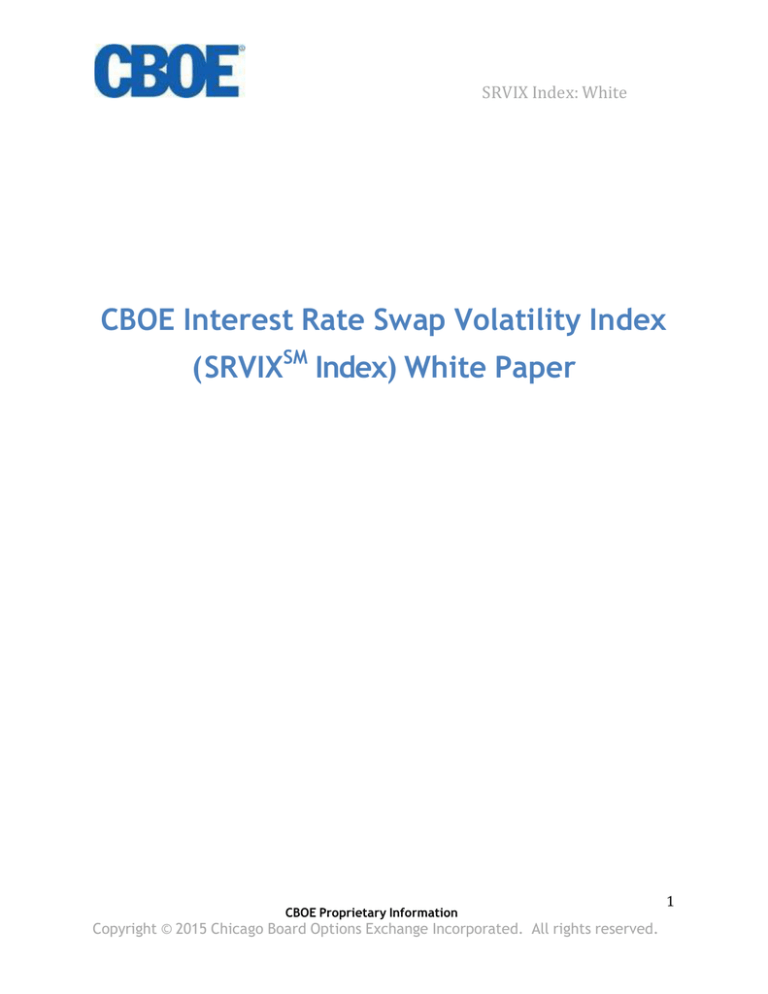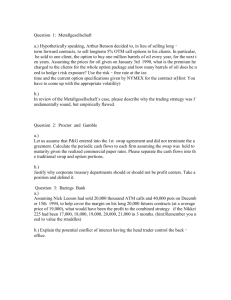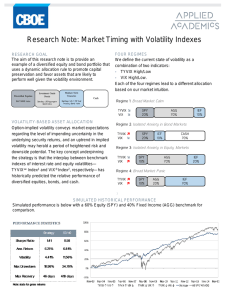CBOE Interest Rate Swap Volatility Index (SRVIX Index) White Paper
advertisement

SRVIX Index: White
CBOE Interest Rate Swap Volatility Index
(SRVIXSM Index) White Paper
CBOE Proprietary Information
Copyright © 2015 Chicago Board Options Exchange Incorporated. All rights reserved.
1
SRVIX Index: White
Scope of the Document
This white paper explains the design and properties of the CBOE Interest Rate Swap
Volatility Index (“SRVIXSM Index” or the “Index”) Methodology. The Index
Methodology measures the fair market value of future volatility implied by the
swaption market for any swaption maturity and tenor of the underlying swap. The
Index differs from at-the-money (ATM) implied volatilities as it incorporates
additional information contained in the entire skew of out-of-the-money (OTM)
swaption prices, serving as the swap rate counterpart to the CBOE Volatility Index®
(VIX® Index) for equity volatility. T h e SRVIX Index is the first interest rate swap
volatility index launched by CBOE and is based on 1Y-10Y US Dollar swaptions.
Acknowledgements
CBOE would like to thank Antonio Mele and Yoshiki Obayashi for their significant
contributions to the development of the CBOE Interest Rate Swap Volatility Index.
CBOE Proprietary Information
Copyright © 2015 Chicago Board Options Exchange Incorporated. All rights reserved.
2
SRVIX Index: White
1. Background: Interest Rate Swaps and Swaptions
INTEREST RATE SWAPS constitute the largest segment of the global over-the-counter
(OTC) derivatives market with over $400 trillion in outstanding notional at the end of
2011.1 Swap rates play a central role in the global financial system as they reflect
term financing rates of major financial institutions and act as benchmarks for
corporate debt funding costs. Moreover, swaps are an important tool for corporate
treasurers, asset managers, and public institutions for hedging interest rate exposure.
As such, the impact of the level and volatility of swap rates is felt in many corners of
the global economy.
The most commonly traded interest rate swaps are known as “vanilla” swaps, in
which two counterparties agree to exchange fixed interest payments for floating
interest payments on a fixed notional amount over a period of time. In the US Dollar
swap market, the floating rate is typically set to the 3-month London Interbank
Offered Rate (LIBOR), which is the short-term lending rate between high credit
quality banks.
Payer
Fixed Rate (e.g. 2.1319%)
Floating Rate (e.g. 3m LIBOR)
Receiver
The swap rate is the fixed interest rate in a swap contract, which is determined such
that the net present value of the fixed cash flows is equal to the expected net
present value of the floating cash flows implied by the forward LIBOR curve. In other
words, it is the fair level of compensation paid to the receiver for bearing the risk of
paying uncertain short-term rates over the life of the swap.
1
Source: Bank of International Settlements: “Semiannual OTC derivatives statistics at end-December
2011”
CBOE Proprietary Information
Copyright © 2015 Chicago Board Options Exchange Incorporated. All rights reserved.
3
SRVIX Index: White
SWAPTIONS are derivative contracts that give the owner the right but not the
obligation to enter into an underlying swap contract. A European-style payer (resp.
receiver) swaption gives the owner the right at maturity to enter into a swap as the
payer (resp. receiver) at a pre-determined fixed rate called the strike. For example,
a receiver swaption on a 10-year swap with a $10 million notional and a strike of
2.1319% maturing in 1-year gives the option holder the right 1-year later to enter into
a 10-year swap with a notional of $10 million receiving a fixed rate of 2.1319% and
paying the 3-month LIBOR. Buyers of swaptions may hedge against or express views
on future changes in swap rates while limiting the downside to the premium paid at
the time of purchase.
Swaptions are customarily quoted in terms of implied volatilities and converted to
premiums using the Black (1976) formula. For any given {maturity, tenor}
combination, the range of strikes and their corresponding implied volatilities is called
the swaption “skew.” The swaption market can be represented as an implied
volatility “cube” in which each available {maturity, tenor, strike} combination is
mapped to an implied volatility. There is an extra dimension compared to the
implied volatility “surface” of equity option markets because the tenor of the
underlying swap introduced an additional parameter.
Figure 1: S&P 500® and 10Y Swap Realized Volatility (1M estimation window)
CBOE Proprietary Information
Copyright © 2015 Chicago Board Options Exchange Incorporated. All rights reserved.
4
SRVIX Index: White
Swap rate volatility has historically behaved differently from volatilities of other
major asset classes such as equities. As an example, Figure 1 above shows that while
realized volatilities of the S&P 500® index and 10-year swap rates share some
common trends, there are periods of significant diversion. Figure 2 moreover shows
that the correlation between the two volatility series fluctuates within a wide range
over time and averages around 51% over the period shown. These observations
suggest that there are drivers unique to swap rate volatility that render it a risk
distinct from volatilities of other asset classes.
Figure 2: Correlation between S&P 500 and 10Y Swap Realized Volatility (1Y Est. Window)
2. CBOE Interest Rate Swap Volatility Index (SRVIX Index)
The SRVIX Index Methodology estimates option-implied fair values of expected
forward swap rate volatilities for various maturities and underlying swap tenors, and
is designed to standardize the way swap market volatility is measured, much as the
VIX® Index did for equity markets. For each maturity and underlying swap tenor,
e.g. 1-year swaption on a 10-year swap, the Index Methodology aggregates implied
volatility information contained in the skew of ATM and OTM swaptions into a single
annualized basis point volatility number. The value of each Index is theoretically
equivalent to a scaled model-free price of a basis point
CBOE Proprietary Information
Copyright © 2015 Chicago Board Options Exchange Incorporated. All rights reserved.
5
SRVIX Index: White
variance swap contract, which leads to a natural interpretation of the index as the
fair market value of forward swap rate volatility.
The SRVIX is the first swap rate volatility index launched by CBOE and is based on
ATM and OTM 1Y-10Y USD swaptions.
THE FORMULA of the Index Methodology on date t for maturity of M years and
underlying swap tenor of T years is
Indext (M,T ) ≡ 1002 ×
2
Receivert (Ki, M,T )∆Ki + ∑ Payert (Ki, M,T )∆Ki
∑
At × M i:K <R
i:K ≥R
i
t
i
t
where Receivert (Ki, M,T ) and Payert (Ki, M, T ) are receiver and payer swaption
premiums, respectively, with strike rate K i , maturity M, and underlying swap tenor
T; Rt is the ATM strike rate; At is the price value of a basis point, also known as the
annuity factor, at time t on the fixed leg of a forward T-year swap starting M-years
from t; and ∆Ki = (Ki+1 − Ki−1 ) / 2 for i ≥ 1, ∆K0 = (K1 − K0 ), and ∆KN = (KN − KN−1 ) where
K0 and K N are the lowest and highest strikes traded in the market with a total of
N +1 available strikes. 2
The SRVIX Index is calculated using the above formula such that SRVIXt ≡ Indext (1,10) .
THE IMPLEMENTATION of the SRVIX is based on real-time feeds of ATM and skew
implied lognormal volatility data from multiple top inter-dealer brokers (IDBs) in the
OTC swaptions market who update their volatility cubes throughout each trading day
based on the deal flows each observes between the major sell-side dealers. As with
most OTC markets, there is no centralized source of unique market-clearing swaption
prices; the more trade flow an institution sees, the more its prices are likely to be
representative of the overall market. Therefore, aggregating data from multiple IDBs,
each of which aggregates information from the major market-makers that further
aggregate information from all of their buy-side clients, provides robustness in the
price discovery process required for CBOE to calculate and disseminate the SRVIX
Index.
2
A technical document with derivations and other details can be found at
CBOE Proprietary Information
Copyright © 2015 Chicago Board Options Exchange Incorporated. All rights reserved.
6
SRVIX Index: White
http://www.cboe.com/SRVIX
CBOE Proprietary Information
Copyright © 2015 Chicago Board Options Exchange Incorporated. All rights reserved.
7
SRVIX Index: White
A SAMPLE CALCULATION for the SRVIX Index is given below based on the 1Y-10Y
swaption implied volatility data shown in Table 1. The lognormal implied volatility
is the volatility parameter σ in the standard swaption pricing formula below based
on Black (1976). The corresponding basis point implied volatility—lognormal implied
volatility multiplied by the forward swap rate—is also given for reference since the
SRVIX is quoted in terms of basis point volatility.
Table 1: Sample 1Y - 10Y Swaption Data
Payer and receiver swaption prices based on the Black (1976) formula are given by:
Payert (K, M, T ) = At ×[RtΦ(d1 ) − KΦ(d2 )]
and
CBOE Proprietary Information
Copyright © 2015 Chicago Board Options Exchange Incorporated. All rights reserved.
8
SRVIX Index: White
Receivert (K, M,T ) = At ×[KΦ(−d2 ) − RtΦ(−d1)]
ln(R / K ) + (σ 2 / 2)M
, d2 = d1 − σ M where σ is the lognormal volatility
M
parameter, Φ is the standard cumulative normal distribution function, and the rest
of the variables are as defined in the previous section. Because the At in the
denominator of the SRVIX formula cancels out the At in the Black (1976) formula, we
only need to calculate [RtΦ(d1 ) − KΦ(d2 )] for payers and [KΦ(−d2 ) − RtΦ(−d1 )] for
receivers, i.e. premium divided by At , which are found in the last two columns of
Table 1.
for d1 =
Table 2: Components of SRVIX
CBOE Proprietary Information
Copyright © 2015 Chicago Board Options Exchange Incorporated. All rights reserved.
9
SRVIX Index: White
Table 2 lists the relevant ATM and OTM swaption premiums divided by At and the
corresponding values of ∆Ki . Multiplying the two and summing across all rows yields
3.9967E-5, which leads to the index value
SRVIXt = Index(12 /12,10) = 1002
×
2
× 3.99671E-05 = 89.40
(12 /12)
which is higher than the ATM implied basis point volatility of 86.66, although this
need not always be the case depending on the shape of the skew.
3. Volatility Trading
VOLATILITY TRADING in the swap market is commonly done through delta-hedged
ATM swaption straddles. In a straddle, a trader buys (resp. sells) a payer and a
receiver with the same maturity, underlying tenor, and strike to go long (resp. short)
volatility of the forward swap rate.
Figure 3: Payoff Diagram of an ATM Straddle
Once initiated, straddles must be dynamically hedged for the strategy to remain
insensitive to movements of the underlying forward swap rate, i.e. delta-neutral.
CBOE Proprietary Information
Copyright © 2015 Chicago Board Options Exchange Incorporated. All rights reserved.
1
SRVIX Index: White
FUTURES AND OPTIONS on CBOE Interest Rate Swap Volatility Indexes3 would
augment existing volatility trading practices by allowing market participants to
capture pure volatility exposure using standardized contracts with payoffs directly
linked to movement in the indexes. Potential uses include:
•
Expressing directional views on implied volatilities of specific maturity/tenor
points
•
Expressing relative value views on implied volatilities between multiple
maturity/tenor points
•
Expressing relative value views between ATM implied volatilities and skew
implied volatilities
•
Hedging fixed income portfolios against the impact of large volatility moves on
fixed income asset prices
•
Hedging against decrease in market liquidity often accompanying volatility
spikes
•
Hedging volatility exposure of structured trades and products
The information in this document is provided for general education and information purposes only,
and is not intended to provide, and should not be relied on for financial or legal advice. The CBOE
Interest Rate Swap Volatility IndexSM (SRVIXSM index) and all other information provided by Chicago
Board Options Exchange, Incorporated (CBOE) and its affiliates and their respective directors,
officers, employees, agents, representatives and third party providers of information (the “Parties”)
in connection with the SRVIXSM Index (collectively “Data”) are presented "as is" and without
representations or warranties of any kind. The Parties shall not be liable for loss or damage, direct,
indirect or consequential, arising from any use of the Data or action taken in reliance upon the Data.
Options involve risk and are not suitable for all investors. Prior to buying or selling an option, a person
must receive a copy of Characteristics and Risks of Standardized Options. Copies are available from
your broker, by calling 1-888-OPTIONS, or from The Options Clearing Corporation at www.theocc.com.
Futures trading is not suitable for all investors, and involves risk of loss. No statement within this
paper should be construed as a recommendation to buy or sell any financial product or to provide
investment advice. Past performance is not indicative of future results. The SRVIXSM index
methodology is the property of CBOE. CBOE®, Chicago Board Options Exchange®, Execute Success®
CBOE Proprietary Information
10
Copyright © 2015 Chicago Board Options Exchange Incorporated. All rights reserved.
SRVIX Index: White
and VIX® are registered trademarks and CBOE Interest Rate Swap Volatility IndexSM and SRVIXSM are
service marks of CBOE. S&P® and S&P 500® are registered trademarks of Standard & Poor’s Financial
Services, LLC and have been licensed for use by CBOE. Financial products based on S&P indices are
not sponsored, endorsed, sold or promoted by Standard & Poor’s, and Standard & Poor’s makes no
representation regarding the advisability of investing in such products. Redistribution, reproduction
and/or photocopying in whole or in part are prohibited without the written permission of CBOE.
3
As of the date of this paper, these products are not available for trading.
CBOE Proprietary Information
11
Copyright © 2015 Chicago Board Options Exchange Incorporated. All rights reserved.



